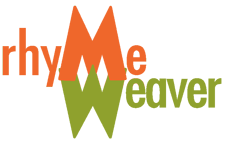104B. Important Meters That Every Writer Should Know
Iambic Pentameter
Iambic Pentameter is considered the Meter most compatible with spoken English, but the Meter most used in children’s writing is probably Anapestic Tetrameter. If these terms seem complicated, just look at the examples below. Meter is really simple.
In 104A, we saw that there are many types of Meter. Each type of Meter is made up of two things:
1. a specific TYPE OF Metrical Foot and
2. a specific NUMBER OF Metrical Feet.
The name of a type of Meter is just a combination of the Foot name and a Greek word for the number of feet per line. That’s really all there is to those long confusing names.
If this doesn’t make sense, just read 104A Metrical Lines again.
IAMB =UNstressed syllable + STRESSED syllable
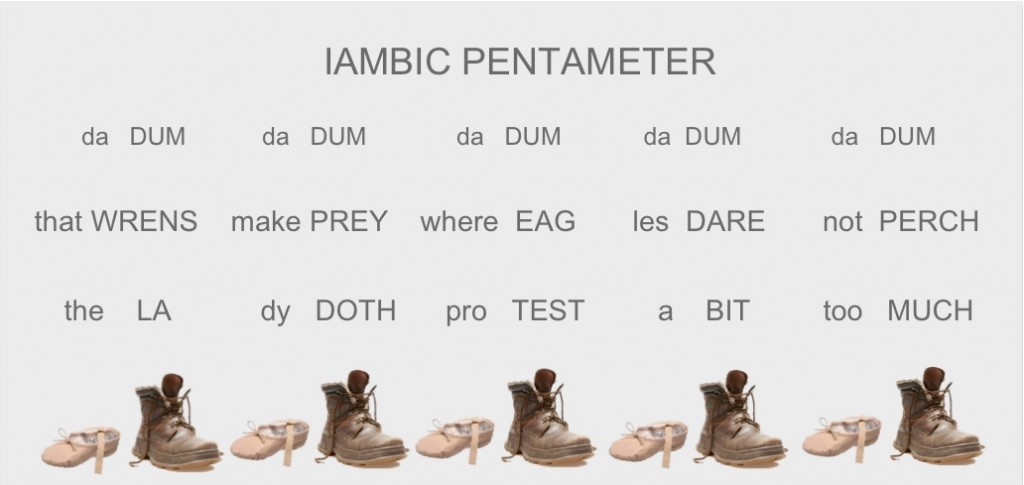 Iambic Pentameter is made up of a specific type of Metrical Foot called, obviously, an Iamb. It must have exactly five of them. You cannot add more Iambs and still have Iambic Pentameter. If you add more feet, say two of them, you will now have Iambic Heptameter. If you look at the section below, you will see that Iambic Heptameter looks a little bit different than Iambic Pentameter. Specifically, Iambic Heptameter is longer by two feet. The box above and to the right shows how two lines of Iambic Pentameter look written with real words. These words happen to be Shakespeare’s, one is from Richard III and the other is from Hamlet. Notice that the Iambs do not coordinate exactly to whole words. Sometimes the various syllables of a single word belong to different metrical feet.
Iambic Pentameter is made up of a specific type of Metrical Foot called, obviously, an Iamb. It must have exactly five of them. You cannot add more Iambs and still have Iambic Pentameter. If you add more feet, say two of them, you will now have Iambic Heptameter. If you look at the section below, you will see that Iambic Heptameter looks a little bit different than Iambic Pentameter. Specifically, Iambic Heptameter is longer by two feet. The box above and to the right shows how two lines of Iambic Pentameter look written with real words. These words happen to be Shakespeare’s, one is from Richard III and the other is from Hamlet. Notice that the Iambs do not coordinate exactly to whole words. Sometimes the various syllables of a single word belong to different metrical feet.
ANAPEST = UNstressed + UNstressed + STRESSED syllable

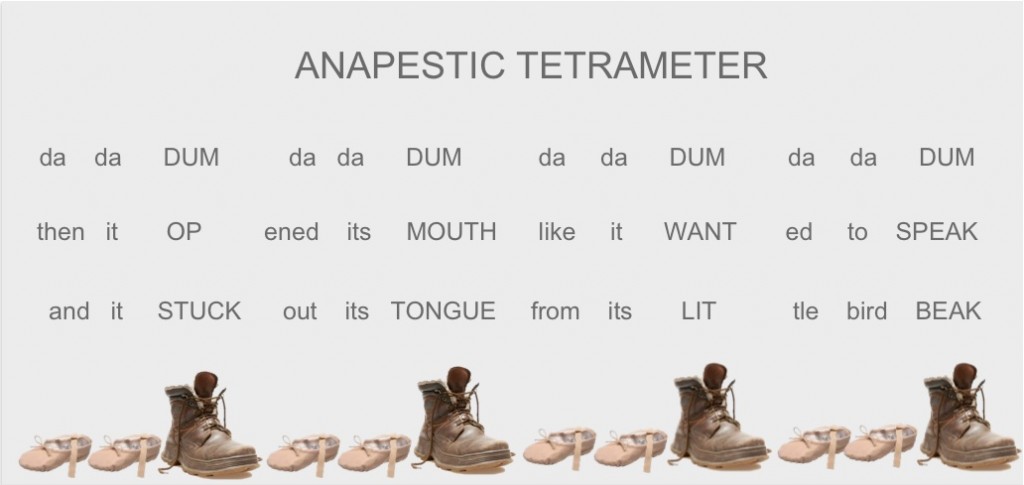
Anapestic Tetrameter is made up of a specific type of Metrical Foot called an Anapest. It must have exactly four of them. From these examples, you can see that Meter is very specific, but also simple. The box to the right shows two lines of Anapestic Tetrameter with real words. You will see this Meter a lot in Children’s books. It is the Meter Dr. Seuss used most often. These lines are from, Watch Your Tongue, Cecily Beasley by Lane Fredrickson. Sterling 2012.
IAMB = UNstressed syllable + STRESSED syllable
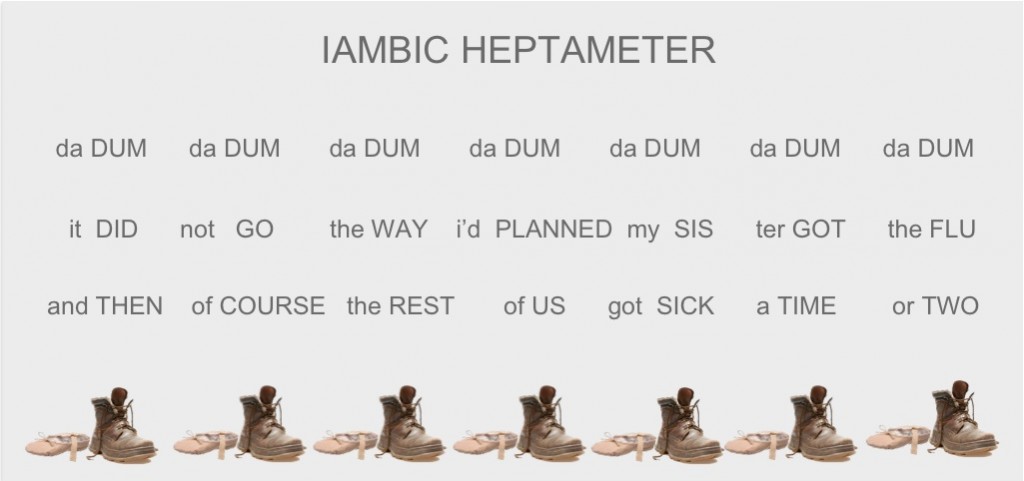 Notice that Iambic Heptameter is made up of Iambs like Iambic Pentameter. It is the same Metrical Foot, but since there are seven of them, it is called Iambic Heptameter. You will see Meters of almost every line length made up of Iambs. In the English language, Iambs are the most commonly used of all the Metrical Feet. But Iambic Pentameter is by far the most often used Meter. It is the Meter used by Shakespeare, Milton, Marlowe, Kyd… The list of English speaking Iambic Pentameter users is pretty long and celebrated, particularly in the 17th and 18th centuries when the only kind of poetry written was written in rhyming verse. Back then, you simply weren’t a poet if you couldn’t put your poem into a metrical form. Fortunately, we have expanded the boundaries of what is considered poetic since then.
Notice that Iambic Heptameter is made up of Iambs like Iambic Pentameter. It is the same Metrical Foot, but since there are seven of them, it is called Iambic Heptameter. You will see Meters of almost every line length made up of Iambs. In the English language, Iambs are the most commonly used of all the Metrical Feet. But Iambic Pentameter is by far the most often used Meter. It is the Meter used by Shakespeare, Milton, Marlowe, Kyd… The list of English speaking Iambic Pentameter users is pretty long and celebrated, particularly in the 17th and 18th centuries when the only kind of poetry written was written in rhyming verse. Back then, you simply weren’t a poet if you couldn’t put your poem into a metrical form. Fortunately, we have expanded the boundaries of what is considered poetic since then.
TROCHEE = STRESSED syllable + UNstressed syllable

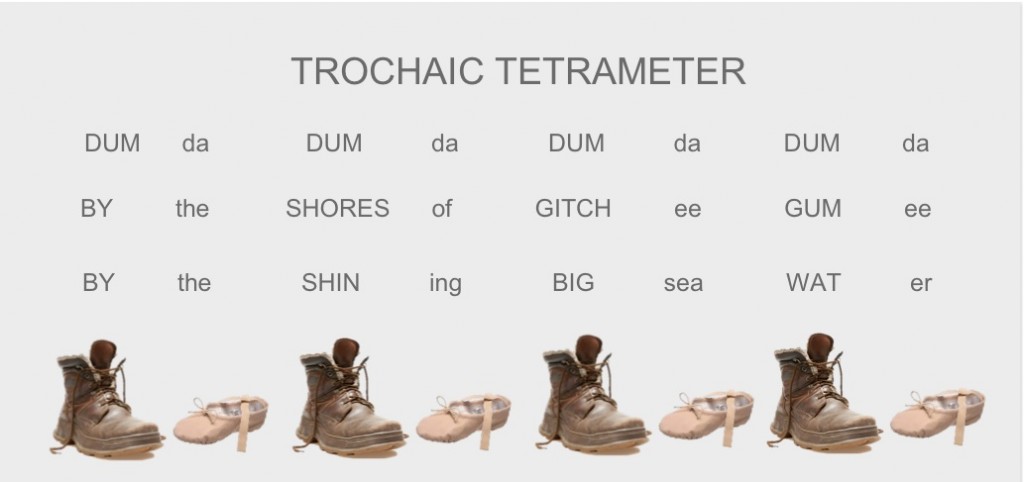 Trochaic Tetrameter is made up of Trochees, exactly four of them. Notice that, above, Anapestic Tetrameter also has four feet. The difference between them is obvious, Anapestic Tetrameter is made up of four Anapests, and Trochaic Tetrameter is made up of four Trochees. Any Meter that is called Tetrameter will have exactly four feet, but the full name of the Meter will depend upon what type of feet the Meter is made up of. The examples at the right show Trochaic Tetrameter with real words. These lines are Longfellow, The Song of Hiawatha.
Trochaic Tetrameter is made up of Trochees, exactly four of them. Notice that, above, Anapestic Tetrameter also has four feet. The difference between them is obvious, Anapestic Tetrameter is made up of four Anapests, and Trochaic Tetrameter is made up of four Trochees. Any Meter that is called Tetrameter will have exactly four feet, but the full name of the Meter will depend upon what type of feet the Meter is made up of. The examples at the right show Trochaic Tetrameter with real words. These lines are Longfellow, The Song of Hiawatha.
For more examples of how Meter works read Metrical Variance.
